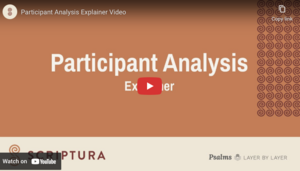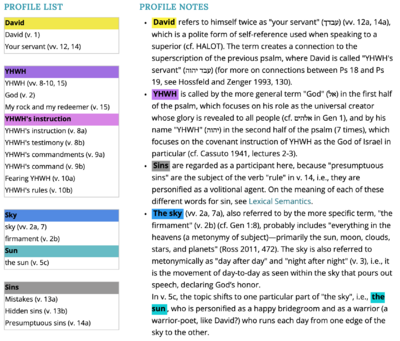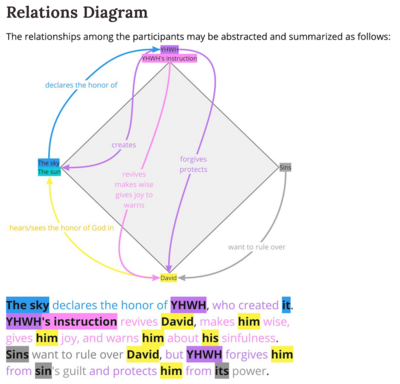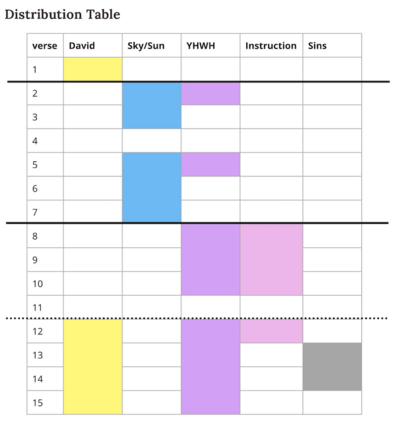User's Guide: Participants
User's Guide Contents
Participant Analysis
The main question of participant analysis is “who is who in the Psalm?” For every verse, we show who is the speaker, who is the audience (which we refer to as the addressee), and who is being referred to within the text iself. For some psalms, identifying these participants is quite straightforward, while for others it can be very unclear and difficult to determine.
Our participant analysis resources include a list of participants, profile notes introducing key participants, a complete participant tracking text, notes, a participant relations diagram, and a distribution table.
At the top of the participant analysis page you’ll find the profile list and the profile notes.
- The Profile List includes a complete list of all participants[1]A participant is an “agent, individual or corporate, who plays a unique relational role in the story of the psalm” (working definition). The main feature here is agency. In the psalms there are many inanimate referents that become participants when ascribed with agency (usually by becoming the subject of a verb). In Ps 98, for example, the sea roars, the rivers clap their hands, and the mountains sing before YHWH. They are all agentive subjects of verbs, and have a participant relationship with YHWH, and are therefore considered participants. However, in other psalms, these same referents are not agentive, and therefore not participants (e.g. Ps. 146 "YHWH...made the sea"). in the psalm, grouped into related sets of participants.
- Each participant is given a unique participant color to clearly track that participant through the rest of our resources.
- Many psalms use different names and titles to refer to the same participant, and these alternative names are listed in the box under the participant. For example, in Psalm 19, three different names are listed for YHWH: YHWH, God, and "My rock and my redeemer".
- The Profile Notes give a brief introduction to the key participants in the psalm and explain any important background information about them.
Beneath the Profile List and Notes we have three tabs, as illustrated below.
Participant Tracking Text
The first tab is our participant tracking text. This is the main resource created in participant analysis, with the full text of the psalm laid out according to all the details of participant analysis.
- For every line of the psalm we identify the speaker and addressee and highlight them according to the unique highlight color shown in the profile list above.
- Every mentionA participant mention includes anything that refers to a participant, including, for example, proper names, titles, nouns, suffixes, pronouns, and the subject of verbs. of a participant within the text is highlighted according to the unique highlight color shown in the profile list above.
- The background of the text is colored according to the color of the speaker. Sometimes, a participant quotes another participant. These quotations are called embedded speech, and in these cases only the middle columns in the participant table change color (not the speaker column!). For example, in this example from Psalm 2 below, the king quotes YHWH, and the speaker column stays yellow (the king's color), but the middle columns become purple (YHWH's color).
Participant Relations Diagram
The next tab is the Participant Relations Diagram. In contrast to the tracking text, which goes into great detail, this diagram tries to present the big picture, showing how all the participants relate to each other. The participants are listed on each of the corners, and their relationships to each other are shown with arrows and text. Beneath the diagram we include a short prose “mini-story” aiming to bring out the key points of the analysis here.
- ↑ A participant is an “agent, individual or corporate, who plays a unique relational role in the story of the psalm” (working definition). The main feature here is agency. In the psalms there are many inanimate referents that become participants when ascribed with agency (usually by becoming the subject of a verb). In Ps 98, for example, the sea roars, the rivers clap their hands, and the mountains sing before YHWH. They are all agentive subjects of verbs, and have a participant relationship with YHWH, and are therefore considered participants. However, in other psalms, these same referents are not agentive, and therefore not participants (e.g. Ps. 146 "YHWH...made the sea").




